C++ Inheritance
Explore C++ inheritace and its variants types.
- Definition.
- Employee Example.
- Single Inheritance.
- Private and Protected Inheritance
- Multiple Inheritance.
Definition.
Inheritance is a way to form new classes based on existing classes, taking on their attributes/behavior.

We can also see Inheritance as a:
- A way to indicate that classes are related.
- A way to share code between two or more related classes (hierarchy).
With this notion, a class can extend another class, abosrbing its data/behavior.
in the OOP vocabulary, we say that:
Superclass(base class): is the parent class that is being extended.Subclass(derived class): Child class that inherits from the superclass.- The subclass gets a copy of every field and method from the superclass.
- Subclass can add it’s own behavior and/or change inherited behavior.
The QT library make heavy use of this mecanism to alleviate the creation of grpahical windows and applications. Here is a simple overview ot its principal component.
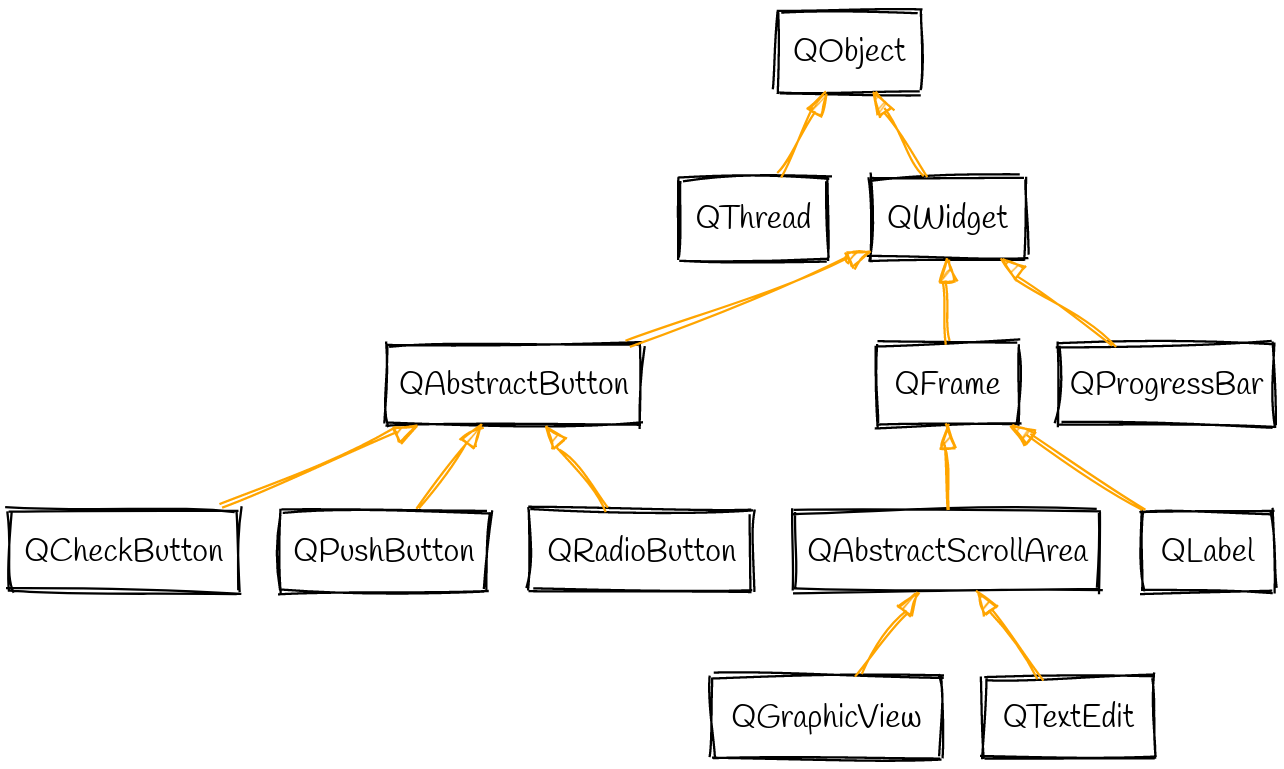
`
From this diagram, we could, for example, check the relation between QWidget
,whish represents the base component of each graphical element, and the
QPushButton for a button that could be clicked.
The QWidget defines the basic behavior of a graphical component such as:
bool enabled(); //if the component could be accessed
QFont font(); // the used font
QRect geometry(); // the occupied geometry
QSize maximumSize(); // define the maximum size
In the hierarchy, we consider the class QAbstractButton to regroup all the properties and behavior of all the buttons such as QPushButton or QRadioButton.
QIcon icon(); // return the icon of the button
QKeySequence shortcut(); // return the keyboard shorcut to activate the button
bool checkable(); //predicate to verify if the button could be checked.
void toggle(); // an Added slot to inform other components
Employee Example.
Lets consider a company with following employee regulations:
- All employees work 40 hours /week.
- Emplyees make $40,000 per year plus $500 for each year worked.
- except for lawyers who get twice the usual pay.
- Programmer who get the same $40k base but $2000 for each year worked.
- Employees have 2 weeks of paid vacation days per year.
- except for programmers who get an extra week (a total of 3).
- Employees should use a yellow form to apply for leave.
- Except for programmers sho use a pink form.
- Each type of employee has some unique behavior:
- Lawyers know how to sue.
- Programmers know how to write code.
- Secretaries know how to take dication.
- Legal Secretaries know how to take dication and how to file legal briefs.
Here is the code for the Employee class:
#define once
#include <string>
using std::string;
class Employee{
public:
Employee(string name, int years);
virtual int hours()const;
virtual string name()const;
virtual double salary()const;
virtual int vacationDays()const;
virtual string vacationForm()const;
virtual int years()const;
private:
string myName;
int myYears;
};
And here is the implementation of these methods:
#include "employee.h"
Employee::Employee(string name, int years){
myName = name;
myYears = years;
}
int Employee::hours() const{
return 40;
}
string Employee::name()const
{
return myName;
}
double Employee::salary()const
{
return 40000.0 + 500 * myYears;
}
int Employee::vacationDays()const
{
return 10;
}
string Employee::vacationForm() const
{
return "yellow";
}
int Employee::years() const{
return myYears;
}
Your task is to implement the Lawyer and Programmer classes:
- Lawyer:
- A Lawyer remembers what law school he/she went to.
- Lawyers make twice as much salary as normal employees.
- Lawyers know how to sue people (unique behavior).
- Programmer:
- Programmer make the same base salary as other employees, but they earn a bonus of 2k/year instead of the usual 500/year.
- Programmers fill the pink form rather than the usual yellow one.
- Programmers get 3 weeks of vacation.
- Programmers know how to write code as their unique behavior.
A Cmake starter code for this project is in Employees.zip.
Single Inheritance.
The syntax of Inheritance in cpp, is as follow:
class Derived : public BaseClass
{
//Additional attributs and methods
};
The associated UML class diagram use a single simple arrow pointing on the base class:
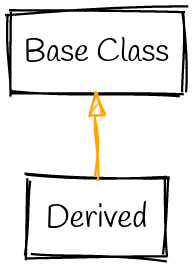
For example, the class diagram for our employee example will be as:
We will give the implementation of the Lawyer class and leave you the
other as an exercise.
First we will create the header lawyer.h an declare the class:
class Lawyer : public Employee
{
public:
//Decide on constructor (either inherit or reimplement)
// See next section
public:
void sue(); //behavior
virtual double salary(); //change the behavior of salary
//Additinal attributes
private:
string school;
};
Constructor Rules.
In C++03, constructors of a class are not allowed to call other constructors in an initializer list of that class. Hence, constructors for base class cannot be directly exposed to derived classes.
Each derived class must implement constructors even if a base class constructor will be appropriate.
Hence for our Lawyer class, we must add an appropriate constructor by adding
the following code in the header file:
Lawyer(string name, int year, string school);
We should also add the implementation of this method on the laywer.cpp as
follow:
Lawyer::Lawyer(string name, int year, string school)
{
this->name = name;
this->year = year;
this->school = school;
}
We can remark that we are repeating code by inintializing the two attributes name and year.
- C++11 allows constructors to other peer constructors(by delegation). This allows constructors to add another constructor behavior with minimum code. We could write the previsou constructor as follows:
//Constructor with delegation to the base class
Lawyer::Lawyer(string name, int years, string school):Employee(name, years)
{
this->school = school;
}
If you want to inherit the base class constructors (Java like) you could use the following syntax:
using BaseClass::BaseClass;
This is an all-or-nothing feature which means that all of the constructors will be inherited.
An inherited constructor will be shadowed if the derived class reimplement its own.
Access Control.
Like Java, C++ offers three access control for the attributs or methods:
- public: Accessible everywhere from any class or code.
- private: Accessible only within the class.
- protected: Accessible within and for child classes.
Perils of Inheritance
Inheritance offer a fast way to reuse code and avoid repetition. But it’s not always best to use it.
Lets consider the following examples:
- A class
Point3Dthat extends aPoint2Dby adding a z coordinate. - A class
Rectanglethat extends a classSquare. - A class
SortedVectorthat extends a simple unordered vector.
Try to think, what could go wrong with these examples!!
- The method
distancewill be completely wrong for a 3D point. -
The Rectangle class supports operations that
Squareshould not likesetWidth. - A
SortedVectormay change the behavior of a given method such asinsert. The user will try insert a value into a given index by will not find that value there.
Private and Protected Inheritance
Similar the access specifiers for attributes, C++ offers three ways of inheriting a class attributes and methods.
-
public Inheritance: makes
publicattributes of the base classpublicand theprotectedattributes remainsprotectedin the derived class. -
protected Inheritance: makes
publicand theprotectedattributes of the base classprotected. -
Private Inheritance copies code from superclass but does not publicly advertise that your class extends that superclass.
class Derived : private Base- Private Inheritance is one way of implementing the has-a relationship.
- Good for cases when you want to inherit another class’s code, but you don’t want the outside clients to randomly call it.
- For example have
Point3Dprivately inherit fromPoint2Dand add a z coordinate functionality.
//Base class
class Base{
public:
int x;
proteced:
int y;
private:
int z;
}
//Public inheritance
class DerivPub : public Base{
// x remains public
// y remains protected
// z in not accessible
}
//protected Inheritance
class DerivPro : protected Base{
// x is now protected
// y remains protected
// z in not accessible
}
//Private Inheritance
class DerivPriv : private Base{
// x is private
// y is private
// z is not accessible
}
Multiple Inheritance.
The concept of inheriting from different source is called mulitple
inheritance.
-
In general is forbidden in many OOP languages like
Javabut is allowed inC++. - Convenient as it allows code sharing from multiple sources.
- In the other hand, is can be buggy and confusing. For example if both the Base classes define the same attribute.
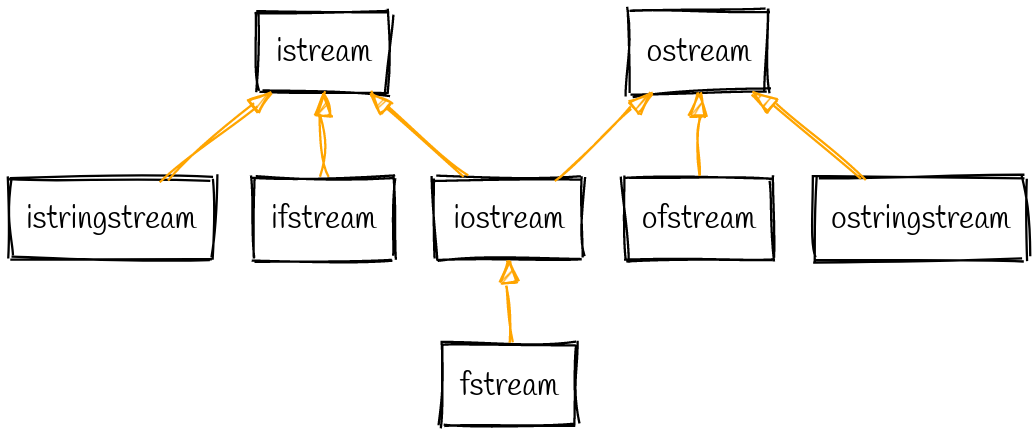
The syntax for inheriting from multiple base class is:
class Name : public SuperClass1, public SuperClass2...
{
}
As an example, let’s consider two simple classes according to the following diagram:
The starter cmake project is in mulitple_inheritance.zip
The first class A is defined as:
class A {
protected:
int a;
public:
//constructor
A(int a):a(a){}
};
The second class is given by:
class B{
protected:
int b;
public:
//constructor
B(int b):b(b){}
};
- Implement the
Cclass by inheriting from A and B. - Implement the
diffmethod which computes the difference between a and b.